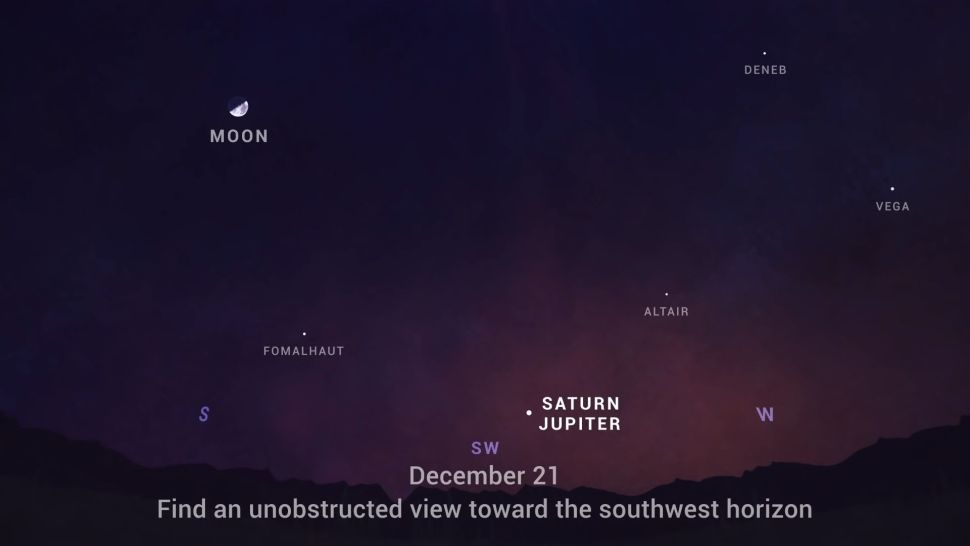How to photograph the winter solstice 'great conjunction' of Jupiter and Saturn tonight
Planning on watching the "great conjunction" of Jupiter and Saturn tonight (Dec. 21)? You can photograph the once-in-800-years event with just the cell phone in your pocket.
Tonight, Jupiter and Saturn will look so close together in the night sky that they will appear as one bright "star." The pair come to a close conjunction once every 20 years, but tonight, the planets will be the closest they have been in the night sky in nearly 800 years.
This doesn't mean that the planets are actually close together out in the cosmos, but they will appear to be right on top of each other from our vantage point on planet Earth.
Great conjunction 2020: NASA tips to see Jupiter & Saturn as a 'Christmas Star'
So, how can you photograph tonight's "great conjunction"?
First, you'll need to find the planets in the night sky. Jupiter and Saturn will appear as one point in the sky and will be much brighter than most other stars in the sky, so bright that you don't need to be at a dark site to see them. Soon after sunset, if you're in the Northern Hemisphere, you'll be able to spot the pair in the southwestern sky. From the Southern Hemisphere, you can spot the planets in the western sky.
Once you've zeroed in on the conjunction, it's time to photograph.
Breaking space news, the latest updates on rocket launches, skywatching events and more!
Related: What was the Star of Bethlehem?
Using a cell phone
If you're using your cell phone, the planets will be bright enough to be visible with your phone's camera. To optimize to your photograph, however, NASA recommends a few tricks.
It won't help much to zoom in on the planets, but framing them can help them to pop in your image, according to NASA. You could also put your phone's camera in "night mode," which is available on some cell phone models and which automatically implements a stabilized long-exposure in your images. You can hold your phone while using night mode, but it's easier to keep it steady for this long exposure if your phone is on a tripod or resting against something.
You could even use a wide-angle lens with your phone, which can be found in the settings of many cell phones. This will allow you to set up the composition of your image and experiment with framing, according to the same guide.
Using a DSLR
If you're using something a bit heftier, like a DSLR camera, NASA has shared a few tips for you as well. For one, you can set your camera's focus to Infinity in Manual Focus mode, which will show the planets in sharper definition. You can also open your aperture as wide as it will go, letting in as much light as possible. With a DSLR, you can also shorten your shutter speed if you're having trouble with unsteadiness.
One of the main advantages to using a camera over a cell phone, if it's available to you, is the ability to use a telephoto lens to see the planets individually and even see their unique features. In fact, with a 200 mm telephoto lens you should even be able to see Jupiter's four Galilean, or largest, moons. With a telescope or a longer lens you could even see Saturn's rings and capture more details in higher resolution.
Tips for everyone
Whatever camera you're using, it can help to use a tripod or steady your camera or phone against something sturdy. This technique can both steady your hand for a clearer photo and allow you to take a longer exposure, letting in more light and helping you put the planets on center stage in your photograph, according to NASA. If you're photographing the planets with a DSLR and a tripod, "use a shutter speed of up to a few seconds. More than this and the Earth's rotation will smear out the planets and stars," NASA suggests in the same guide.
No matter what camera you're using to photograph the event, you will have one or two hours when the planets are visible in the early evening, shortly after sunset. During this time, the sky will be changing colors and getting darker. By staying out throughout this time, you can try photographing the conjunction in different lights as the sky changes, capturing the planets with the sunset and with the dark night sky, NASA suggests.
Additionally, while you might just be trying to capture the conjunction itself, if you play around with your photograph's composition, framing the planets with trees or buildings in the foreground, it can add visual interest and perhaps emphasize the bright point of light that brought you outside, according to NASA.
Whatever method you're planning on viewing and photographing the event with, keep your fingers crossed for good weather as clouds could get in the way of witnessing a clear, bright "great conjunction."
Editor's note: If you capture an amazing view of the great conjunction of Dec. 21 and would like to share it with Space.com for a story or gallery, send images and comments in to spacephotos@space.com.
Email Chelsea Gohd at cgohd@space.com or follow her on Twitter @chelsea_gohd. Follow us on Twitter @Spacedotcom and on Facebook.

Chelsea “Foxanne” Gohd joined Space.com in 2018 and is now a Senior Writer, writing about everything from climate change to planetary science and human spaceflight in both articles and on-camera in videos. With a degree in Public Health and biological sciences, Chelsea has written and worked for institutions including the American Museum of Natural History, Scientific American, Discover Magazine Blog, Astronomy Magazine and Live Science. When not writing, editing or filming something space-y, Chelsea "Foxanne" Gohd is writing music and performing as Foxanne, even launching a song to space in 2021 with Inspiration4. You can follow her on Twitter @chelsea_gohd and @foxannemusic.

